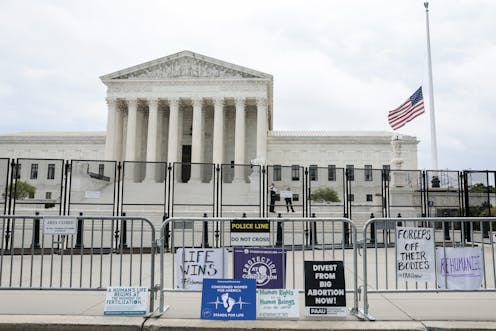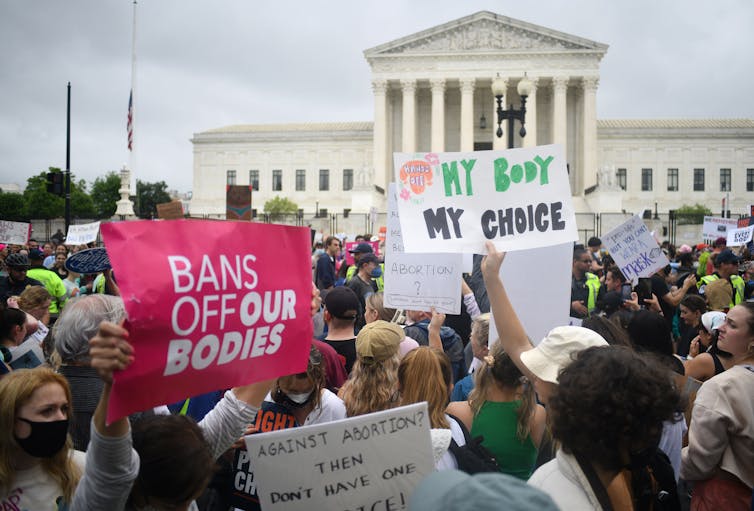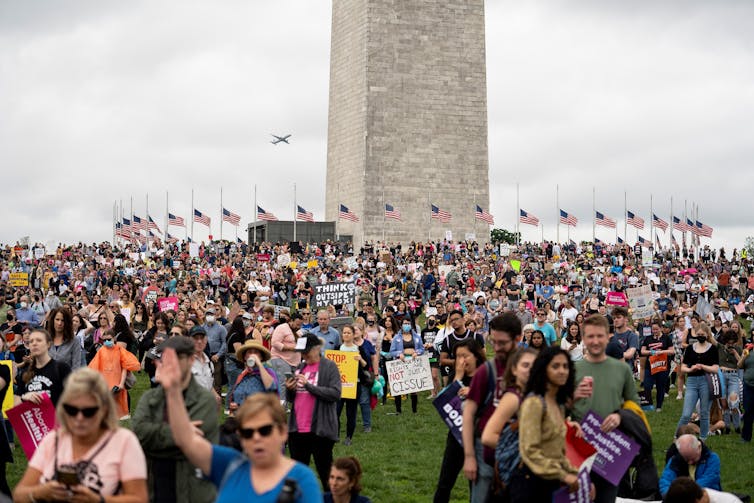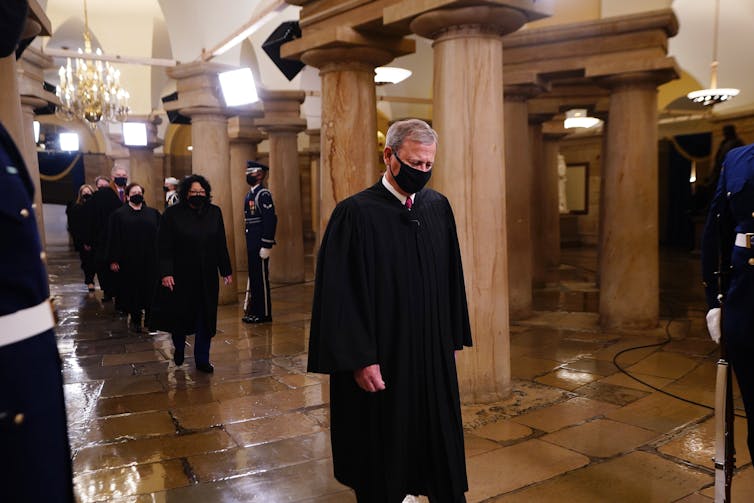
The U.S. Supreme Court is set to announce a decision that could possibly overturn Roe v. Wade, the 1973 case that guaranteed the constitutional right to abortion.
The court is currently considering a case known as Dobbs v. Jackson Women’s Health Organization, which questions the constitutionality of a Mississippi law that bans abortion after 15 weeks of pregnancy.
But a leaked draft majority opinion was published by Politico on May 2, 2022, indicating that a majority of justices had voted to allow the post-15-week abortion ban, which would overturn Roe v. Wade.
The Court has confirmed the authenticity of the February draft, but a final decision in the case has not been announced.
Most of the Supreme Court’s deliberations occur behind closed doors. And while other information has leaked from the court before, this kind of public circulation of a majority opinion draft is unprecedented.
As an expert on the Supreme Court, I think understanding the court’s decision-making process can help make sense of the leaked draft’s significance and the influence it is having on the court’s credibility. Here are four key points to consider.

1. How are Supreme Court opinions drafted?
Shortly after hearing oral arguments, Supreme Court justices meet privately without legal clerks or staff to discuss and take a preliminary vote on how to resolve the case.
These initial votes are not the final decision. Justices can, and sometimes do, change their minds during the opinion drafting process. Drafting the opinion can take anywhere from a few weeks to several months in more contentious cases.
While tentative, the first votes are significant because they determine the group of justices eligible to write the opinion that could set a legally binding precedent for future cases and legal questions.
There are nine Supreme Court justices. A majority, or at least five, need to jointly support any final decision on a case in order to set precedent.
The author of the majority opinion is selected by the most senior justice who initially voted with the majority. Since Justice Anthony Kennedy’s retirement in 2018, either Chief Justice John G. Roberts or the most senior Associate Justice, Clarence Thomas, most often chooses who authors the majority opinion.
The selected justice works with his or her team of legal clerks to write an initial draft of the opinion, which explains the legal basis for voting one way or another. The draft is then shared with the eight other justices.
Next, the other justices have an opportunity to weigh in on the content of the majority opinion and attempt to modify its language. Those in the majority have the greatest influence on the draft, but majority opinion authors may respond to points made in a draft dissent. A final decision is reached once all justices have authored or signed onto an opinion.
Justices not in the majority can write or sign onto dissenting or concurring opinions, which do not carry legal authority.
2. How much can draft opinions change over time?
In theory, a Supreme Court majority opinion draft can be completely rewritten.
Enough justices could also change their minds and create a new majority, which supports a different resolution to a case. However, since justices have already read written briefs – meaning a written legal argument submitted by each side in the case – and considered the case with their colleagues, a complete overhaul of a given majority opinion draft is unlikely.
Some revision to a majority opinion draft is common, though.
This is because the majority opinion author must craft language that will secure the votes of at least four other justices. Justices can negotiate over specific wording and also push for larger, substantive revisions.
This drafting process usually results in multiple versions. A final opinion ultimately reflects the views of all of the justices in the majority.
Majority opinion authors are more likely to circulate additional opinion drafts in cases where the justices are closely split – meaning five justices plan to vote opposite four others – and in complex cases. There is more pressure for a majority opinion author to accommodate the other justices’ views in split decisions, since losing one vote would reverse the case outcome.

3. Why are draft opinions kept private?
The court sets a lot of its own policies, including which cases they accept, the format of oral arguments and opinion drafting procedures.
Justices have repeatedly argued that private deliberations are essential to the court’s decision-making. As former Justice Lewis F. Powell said in 1980, “There must be candid discussion. … The confidentiality of this process assures that we will review carefully the soundness of our judgments.”
The court’s procedures promote judicial independence and are designed to establish distance from public opinion and political pressure.
Some observers have argued the court should be more transparent, saying that increased access to things like court proceedings and information regarding when and why justices must recuse themselves from cases would strengthen the accountability of the court.
Roberts has defended the court’s decision-making process, saying in June 2018, “It’s not as if we’re doing this in secret. We’re the most transparent branch in government in terms of seeing us do our work and us explaining what we’re doing.”

4. What is the significance of a leaked opinion draft?
The release of the draft opinion is rare and meaningful – it violates the Supreme Court’s strict expectation of confidentiality among clerks, justices and staff.
Shortly after the draft opinion’s release, Roberts called the leak “absolutely appalling” and an “egregious breach” of trust.
Thomas said it was “tremendously bad,” likening it to an “infidelity” that cannot be undone.
Although the full ramifications of the leak are not yet known, this breach of trust could change the openness with which justices discuss cases internally.
Scholars and the public have previously seen records of the court’s internal discussions and early opinion drafts through justices’ personal papers. But justices typically do not make their personal papers available until they have retired or died.
Ultimately the leaked opinion draft places a spotlight on the Supreme Court that the institution prefers to avoid.
The leaked draft sparked protests outside the Supreme Court building defending Roe v. Wade and new proposed legislation that would establish abortion as a federal right. Following the leak in early May, the Supreme Court installed security fencing.
The draft opinion also brought a wave of criticism from outside experts about the legitimacy of the court.
Suggestions that the court has become politicized are a potential problem for an institution that relies on public credibility and good will to be able to enforce its decisions.
Eve Ringsmuth does not work for, consult, own shares in or receive funding from any company or organisation that would benefit from this article, and has disclosed no relevant affiliations beyond their academic appointment.
This article was originally published on The Conversation. Read the original article.







